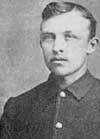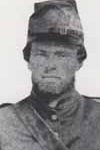 Stanislas Roy (left) was born in France on November 12, 1846. He enlisted in the Seventh Cavalry in 1869 and served on both the Yellowstone and Black Hills expeditions. He later served as a corporal in Company A in the valley and hilltop fights at Little Bighorn. He was awarded the Medal of Honor on October 5, 1878, with the citation: “Brought water to the wounded under a most galling fire.” Roy attended the dedication of the Custer Monument in Monroe, Michigan, in 1910 and died of cancer in 1913 at Columbus Barracks, Ohio. He was buried in Green Lawn Cemetery in Columbus, Ohio.
Stanislas Roy (left) was born in France on November 12, 1846. He enlisted in the Seventh Cavalry in 1869 and served on both the Yellowstone and Black Hills expeditions. He later served as a corporal in Company A in the valley and hilltop fights at Little Bighorn. He was awarded the Medal of Honor on October 5, 1878, with the citation: “Brought water to the wounded under a most galling fire.” Roy attended the dedication of the Custer Monument in Monroe, Michigan, in 1910 and died of cancer in 1913 at Columbus Barracks, Ohio. He was buried in Green Lawn Cemetery in Columbus, Ohio.
William Sadler died on November 12, 1921, in Linton, North Dakota, and was buried the following day in the Linton Cemetery. He was a Private in Company D who was not present at the Little Bighorn due to detached service at Powder River.
 Patrick Coakley (right) died in Washington, D.C., on November 13, 1881, and was buried in the Soldiers’ Home National Cemetery there. He was a Private in Company K who was not present at the battle due to detached service.
Patrick Coakley (right) died in Washington, D.C., on November 13, 1881, and was buried in the Soldiers’ Home National Cemetery there. He was a Private in Company K who was not present at the battle due to detached service.
Thomas H. Rush died on November 13, 1905, in Elmhurst, Alameda County, California. He was a Sergeant in Company D who was not present on the campaign because he was in the hospital at Fort Abraham Lincoln, Dakota Territory.
 William C. Slaper (left) died on November 13, 1931, in Sawtelle, California, and was buried in the Los Angeles National Cemetery. He was a Private with Company M who participated in the valley and hilltop fights. He attended the 50th Anniversary Reunion of the battle in 1926.
William C. Slaper (left) died on November 13, 1931, in Sawtelle, California, and was buried in the Los Angeles National Cemetery. He was a Private with Company M who participated in the valley and hilltop fights. He attended the 50th Anniversary Reunion of the battle in 1926.
Frederick Francis Girard was born on November 14, 1829, in St. Louis, Missouri. On November 15, 1877, he married Ella Scarborough Waddell. He had previously been married to a Piegan Indian. Girard was an interpreter who participated in the valley fight.
 Edward Rood (right) was born in Tioga County, New York, on November 14, 1847. He was a Private in Company E and was killed in the battle.
Edward Rood (right) was born in Tioga County, New York, on November 14, 1847. He was a Private in Company E and was killed in the battle.
Marcus Albert Reno was born on November 15, 1834, in Carrollton, Illinois. Entire books have been written about Major Reno because he played a significant role in the battle.
Frank Volkenstine, who was also known as Frank Bowers, was born on November 15, 1844, in Birmingham, Michigan. He was a Private with Company M, but he was not on the campaign because he was dishonorably discharged in Fort Wayne, Michigan, on May 31, 1876.
Markus Weiss died on November 15, 1879, at Fort Meade, Dakota Territory, as a result of a compound fracture of his neck he received from a cave-in of a gravel bank, and was buried in the Fort Meade National Cemetery. He was a Private with Company G who participated in the valley and hilltop fights.
Henry James Nowlan died in Hot Springs, Arkansas, on November 10, 1898, and was buried at the Little Rock National Cemetery in Little Rock, Pulaski County, Arkansas. He was a First Lieutenant with the Quartermaster unit who was not present at the battle due to detached service.
James J. Galvan, also known as Michael J. Miller, was born in Liverpool, England, on November 16, 1848. He was a Private in Company L and was killed in the battle.
Hugh McGonigle died on November 16, 1916, in Washington, D.C. , and was buried in the Soldiers’ Home National Cemetery there. He was a Private in Company G who fought in the valley and hilltop fights.
 Emil Taube (left) was born on November 18, 1847, in Damerau, Germany. He was a Private in Company K who was on detached service at Yellowstone Depot during the battle.
Emil Taube (left) was born on November 18, 1847, in Damerau, Germany. He was a Private in Company K who was on detached service at Yellowstone Depot during the battle.
Frederick Henry Gehrmann was born in Baltimore, Maryland, on November 18, 1855. He was a Private in Company B who was on detached service at Yellowstone Depot during the battle.
James Hill died in Wooster, Ohio, on November 18, 1906, and was buried in the Wooster Cemetery two days later. He was the First Sergeant of Company B who was a pack train escort and fought on the hilltop.